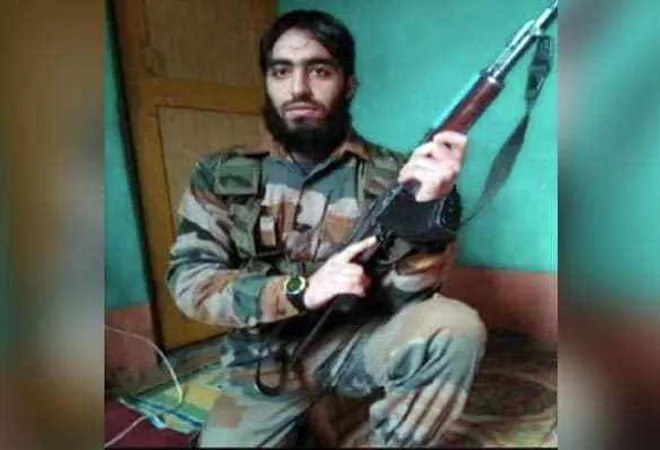
Riyaz Naikoo was a senior among the young crop of new militants in Kashmir. Having been involved with militancy as an overground worker of previous Hizbul Mujahideen commander Yaseen Yatoo, he graduated to the role of an active militant in the year 2012 and remained active for almost a decade. Even though he lacked the showmanship, emotional appeal, charisma and widespread public recognition of Burhan Wani, his organisational prowess, brute and ruthless approach to operations brought lethality to HM and made it a force to reckon with.
Naikoo before this death was the most wanted militant in Jammu and Kashmir and undoubtedly the most popular in current times. But his popularity was of no match to that of Burhan Wani or Zakir Musa. He took charge of Hizbul Mujahideen after the death of Burhan Wani, adopting the nom de guerre of Muhammad Bin Qasim. After Wani’s death, there was a gush of young men willing to join militant outfits. However, Hizbul was in disarray. Zakir Musa’s open rebellion against the Hizbul leadership, the separatists, and Pakistan Army had resulted in factionalism within the outfit. Wani’s death had left a void which many of his lieutenants tried to fill without much success.
Wani used social media to glamourise and glorify militancy. Naikoo weaponised it by using the viral power of the medium to set examples that would terrify people for years.
Instrumental in bringing discipline and order into the chaos that ensued in HM after the death of Wani, Naikoo was crucial in the centralisation of the leadership of the organisation, streamlining its operations, steering its ideological moorings more in favour of the handlers across the border and most importantly picking the recruits from the wave of angry young men inspired by the Rambo-like image of Wani.
Wani used social media to glamourise and glorify militancy. Naikoo weaponised it by using the viral power of the medium to set examples that would terrify people for years. Under his command, Hizbul turned into a killing machine. Even though the outfit barely conducted any big terror strike, under Naikoo, it slaughtered civilians after labeling them as informants of security forces. Releasing confession of being an informant, videos of civilians recorded minutes before the assassination were released online. At times the act of killing itself was recorded and published on social media to instill terror among the masses.
The most threatening operation conducted by the outfit under his leadership was the abduction and targeted killing of security forces personnel in South Kashmir. Scores of cops were killed by the Hizbul Mujahideen during his reign.
The targeting killing of security officials became a norm through 2017 and 2018 in southern Kashmir.
In 2018, havoc ensued when dozens of cops and their family members were killed by Hizbul Mujahideen in retaliation over detention of family members of Naikoo and Hammad Khan, another commander of HM. The abduction of family members of policemen led to a frenzy. It is believed that the top officials of police negotiated a deal to seek the release of the relatives.
Weeks after these abductions, cops were once again abducted and forced to announce their resignations openly. Videos appeared online of serving cops issuing resignation in public and disassociating themselves from the police force. This was a big blow to the security establishment as the Operation All Out against the militancy was in full swing.
The targeting killing of security officials became a norm through 2017 and 2018 in southern Kashmir. So much so that the cops and troops would desist from visiting their homes for months. A few weeks before Naikoo’s killing, the targeted killing and even the abduction of security personnel had restarted after a hiatus of many months.
Unlike Burhan Wani who was against the killing of civilians, Hizbul Mujahideen under Naikoo had no shame in admitting to the killing of civilians.
Naikoo had a no-nonsense approach to the killing of civilians and unarmed security forces. Unlike Burhan Wani who was against the killing of civilians, Hizbul Mujahideen under Naikoo had no shame in admitting to the killing of civilians. Under his reign, the targeted killing of civilians, off duty cops and political workers continued unabated. It needs to be seen whether his killing will result in some changes in the strategy of HM.
What does Naikoo’s death mean for Hizbul Mujahideen?
Naikoo’s killing is a classic case of leadership decapitation, however this was not the first instance where the topmost leader of a militant outfit was killed in Kashmir. Burhan Wani’s encounter is a case in point. After Wani’s killing, many commanders and high-ranking militants other militant groups have been killed since 2016.
Militant outfits operating in Kashmir have immediately replaced a slain leader and maintained discipline within the ranks of their organisations. This is primarily because the operations of militant outfits active in Kashmir are directed by the leadership of each outfit based in Pakistan. In the case of Hizbul Mujahideen, it is Mohammad Yousuf Shah a.k.a Syed Salahuddin.
Leadership decapitation may at best lower the morale among the cadre of an organisation; it does not however decimate the outfit because the strings are pulled not just by the leaders across the border, but also by the Pakistan Army.
Leadership decapitation may at best lower the morale among the cadre of an organisation; it does not however decimate the outfit because the strings are pulled not just by the leaders across the border, but also by the Pakistan Army. This is why an outfit such as the Hizbul Mujahideen has lasted for more than 30 years in Kashmir despite major defections, including the surrender of topmost leaders such as Majid Dar, who joined talks with the government of India in the year 2000.
Within a day of Naikoo’s killing, Doctor Saifullah of Pulwama is believed to have been appointed as Naikoo’s successor. Even so, Naikoo’s successor will have a tough maintaining the ranks of HM intact, and ensure that the cadre of the organisation doesn’t desert to groups like Ansar ul Gazwat un Hind. He will also have to contend with the fact that Hizbul has lost a wily, experienced recruiter and will suffer on that front. But the most pertinent question after Naikoo’s death is whether Hizbul Mujahideen as an outfit matters anymore? Already in the last two years, groups like LeT and JeM had recruited more local Kashmiris than the HM. With the creation of new outfits such as The Resistance Front, the role of Hizbul Mujahideen seems diminished. If the sources in security establishment are to be believed, Naikoo in his last days was miffed with the handlers of his outfit across the border as he and his men felt short-changed by Pakistan.
The views expressed above belong to the author(s). ORF research and analyses now available on Telegram! Click here to access our curated content — blogs, longforms and interviews.




 PREV
PREV


